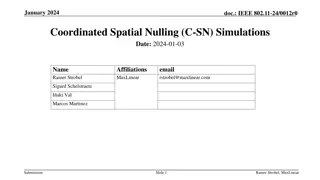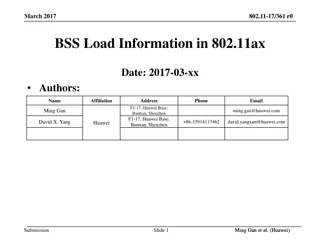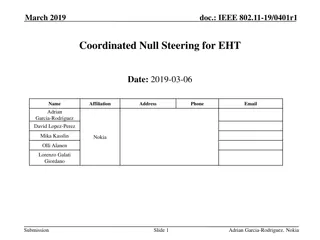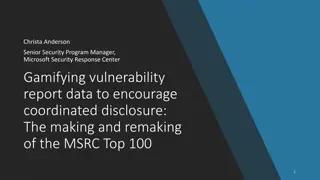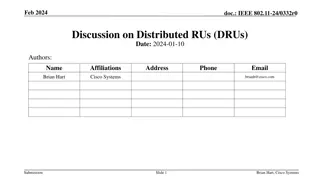Coordinated Spatial Reuse
Explore the concept of Coordinated Spatial Reuse (C-SR) in IEEE 802.11 networks, a scheme where multiple access points (APs) transmit data simultaneously to reduce interference and enhance resource utilization. Learn about the definition, benefits, and necessary components for successful C-SR operat
0 views • 15 slides
Coordinated Spatial Reuse in IEEE 802.11bn Standard
This contribution explores Coordinated Spatial Reuse (Co-SR) as a potential multi-AP feature for the IEEE 802.11bn standard. It discusses the trade-offs, proposes a method for downlink channel access, and evaluates its impact on goodput and packet delivery delay. The background highlights the gains
1 views • 17 slides
Understanding Coordinated Beamforming and MU-MIMO in IEEE 802.11-23/1998r0
This document delves into the intricacies of Coordinated Beamforming (Co-BF) and MU-MIMO techniques in the context of IEEE 802.11-23/1998r0 standard. It explores the concept of nulling in Co-BF, handling more Rx antennas than streams, Zero-Forcing precoding to eliminate Multi-User Interference (MUI)
2 views • 22 slides
Analysis of Power Control for Coordinated Spatial Reuse in IEEE 802.11-24
Evaluation of power control schemes for Coordinated Spatial Reuse (CSR) in IEEE 802.11-24, comparing benefits with and without power control. Results show gains in throughput and SINR with different CSR schemes and considerations for shared access points. Concerns and insights shared on the effectiv
6 views • 24 slides
Gain Analysis for Coordinated AP Transmissions in IEEE Enterprise R3 Network
This document discusses gain analysis results for coordinated AP transmissions in the IEEE Enterprise R3 network, focusing on tail latency gain for aperiodic traffic. Simulation setups, topology details, and results for different coordination schemes (C-TDMA, C-RTWT, and combined) are provided, show
5 views • 6 slides
Thematic Working Group for Libya Flood Responses - Updates and Coordination Efforts
Thematic Working Group for Libya Flood Responses held a meeting on 17 October 2023 to discuss coordinated responses, targeting needs and damage assessments. Updates and documents published by partners after 10 October 2023 were shared, including reports from SRSG Abdoulaye Bathily and various agenci
0 views • 10 slides
Coordinated Roaming Proposal for IEEE 802.11 Networks
This document presents a proposal for coordinated roaming through target AP MLD in IEEE 802.11 networks to address connectivity disruptions due to sudden RSSI drops or STA transition scenarios. The solution aims to ensure data continuity, preserve context, and minimize data loss during roaming hando
0 views • 11 slides
Understanding Coordinated Entry System (CES) in Homeless Services
Coordinated Entry is a strategic approach focusing on housing and service coordination to link individuals experiencing homelessness to appropriate resources. With a primary goal of quick identification and prevention of homelessness, the system assesses consumer needs and connects them to housing a
0 views • 12 slides
Bitmap Indication for OFDMA Transmission
Dec. 2020 introduces a preamble puncture bitmap indication for 20/40 MHz OFDMA transmission, proposing to use '1111' when no puncturing is applied. The straw poll suggests adding this indication to the TGbe SFD. The submission highlights the specific bit values for punctured 20 MHz channels within a
2 views • 5 slides
Coordinated AP Time/Frequency Sharing in IEEE 802.11be
The document discusses Coordinated AP (CAP) Time/Frequency Sharing in Transmit Opportunity in IEEE 802.11be, focusing on Frequency and Time resource sharing between multiple APs in close proximity. It introduces concepts like CAP OFDMA and CAP TDMA, outlining the benefits in terms of latency improve
0 views • 15 slides
IEEE 802.11-20/1238r5 August 2020 Preamble Design Open Issues
In these slides, designs for U-SIG content & overflow and EHT-SIG design are proposed. The focus is on punctured channel indication design with the aim of conveying puncturing patterns efficiently while keeping signaling overhead low. The proposal includes a 6-bit field for puncturing information, a
1 views • 41 slides
Considerations on Coordinated OFDMA Operation in IEEE 802.11
The document discusses the Coordinated OFDMA (C-OFDMA) operation as a part of Multi-AP coordination schemes within the IEEE 802.11 standard. It covers resource allocation options, topology considerations, resource allocation methods, capability announcement procedures, and negotiation processes betw
0 views • 15 slides
Understanding Multi-AP Operation in IEEE 802.11-20-0617/r3
Explore the basic definitions and key features of Multi-AP operation in the IEEE 802.11 standard. Learn about Multi-AP Candidate Set (M-AP-CS) and Multi-AP Operation Set (M-AP-OS) along with their participants and formation. Delve into the concepts of Coordinator AP, Coordinated AP(s), and reliable
0 views • 19 slides
Efficient Coordinated Spatial Reuse in IEEE 802.11-23
Coordinated Spatial Reuse (C-SR) is a Multi-AP transmission technique proposed for UHR networks that enhances efficiency by utilizing RSSI or pathloss feedback instead of complete CSI. This document introduces an efficient protocol for C-SR, focusing on a unified approach for better implementation.
0 views • 10 slides
Understanding IEEE 802.11-20/0410r4 Coordinated Spatial Reuse Procedure
This document presents the Coordinated Spatial Reuse (CSR) procedure in IEEE 802.11-20/0410r4, focusing on the transmission schemes and necessary information for effective spatial reuse. It outlines the topology of CSR environments, acquisition of information for CSR, CSR capability announcement by
8 views • 23 slides
Coordinated AP Time/Frequency Sharing in IEEE 802.11be
The document discusses the concept of Coordinated AP (CAP) Time/Frequency Sharing within a Transmit Opportunity (TXOP) in the IEEE 802.11be standard. It explains the procedures of Frequency and Time resource sharing, highlighting the benefits such as latency improvement and throughput fairness. Deta
0 views • 16 slides
Coordinated Spatial Reuse in IEEE 802.11 Networks
The document discusses Coordinated Spatial Reuse (C-SR) in IEEE 802.11 networks, focusing on downlink transmission. C-SR is a multi-AP coordination scheme aimed at enhancing spectrum efficiency by reusing time/frequency resources among multiple Basic Service Sets (BSSs). The procedure is divided int
1 views • 24 slides
Contrasting Parkinson's Pathways: Sub-optimal vs Optimal
Sarah's journey with Parkinson's illustrates the stark difference between a sub-optimal pathway leading to distress and a well-coordinated optimal pathway resulting in a peaceful end at home. Timely diagnosis, specialized support, coordinated care, and proactive interventions played key roles in Sar
1 views • 8 slides
Understanding the Humanitarian Programme Cycle (HPC)
The Humanitarian Programme Cycle (HPC) is a coordinated series of actions aimed at preparing for, managing, and delivering humanitarian responses efficiently. It focuses on delivering fast, coordinated, effective, and protection-driven aid to those affected by crises. Central to the HPC is the invol
2 views • 8 slides
Overhead Analysis of Coordinated Spatial Reuse in IEEE 802.11-23
Analysis of overhead components impacting the performance of Coordinated Spatial Reuse (Co-SR) in IEEE 802.11-23 standard for wireless communication. Evaluation of MAC overhead, negotiation and measurement phases, and frames in the negotiation phase. Discussion on the impact of overhead on Co-SR per
0 views • 14 slides
Proposal for IEEE 802.11-23/1984r1 TGbi Coordinated MAC Rotation
The document discusses a proposal for IEEE 802.11-23/1984r1 TGbi focusing on coordinated MAC rotation, EDP epochs, anonymity sets, and group epochs. It introduces concepts like individual and mass rotations, anonymity set size, and hiding in the crowd examples. The coordination for group epochs and
1 views • 10 slides
Enhancing Support for Wider Bandwidth OFDMA in IEEE 802.11 Networks
The document discusses the implementation of Selective Spatial Transmission (SST) and Dynamic Subband Operation (DSO) to enable wider bandwidth OFDMA in IEEE 802.11be and 802.11bn standards. It covers enhancements for 80MHz, 160MHz, and 320MHz EHT DL and UL OFDMA transmissions, emphasizing the benef
0 views • 18 slides
Coordinated Spatial Nulling (C-SN) Simulations in IEEE 802.11-24/0012r0
The document discusses the concept of Coordinated Spatial Nulling (C-SN) in IEEE 802.11-24/0012r0, focusing on spatial nulling feedback, synchronization needs, advantages of partial nulling, and comparison of half-coordinated versus fully coordinated scenarios. Simulation results are presented, anal
0 views • 19 slides
Enhancing BSS Load Management in 802.11ax Networks
Proposed changes to address load balancing issues in dense 802.11ax scenarios by introducing a new information element for BSS Load. The new element considers OFDMA utilization, UL/DL MU-MIMO, and allows for future extensions to ensure efficient AP selection by unassociated STAs. Enhancements aim to
0 views • 14 slides
Coordinated Assessment System Committee Meeting Overview
The Coordinated Assessment System Committee convened on May 22, 2024, with a focus on various agenda items including HUD technical assistance updates, governance board information, and policies and procedures review. The committee discussed the submission of technical assistance requests to HUD, pot
0 views • 10 slides
Evaluating and Improving Coordinated Entry Systems
Community should regularly evaluate their coordinated entry systems to ensure proper functioning and identify necessary refinements for continuous improvement. Evaluation helps in maintaining effectiveness and efficiency of the system, benefiting all stakeholders involved in the process.
0 views • 27 slides
Coordinated Beamforming/Null Steering Protocol in IEEE 802.11be
Coordinated beamforming/null steering is a promising scheme in IEEE 802.11be for joint transmission/reception challenges. This protocol aims to efficiently realize gains by establishing semi-static inter-AP coordination, enhancing spatial reuse opportunities, implementing CSI acquisition, and managi
0 views • 15 slides
Coordinated Null Steering for Enhanced Wireless Communication
Null steering in wireless technology allows devices to place spatial radiation nulls towards non-served STAs for interference suppression, improving spatial reuse and mitigating inter-cell interference. This document discusses null steering-related proposals in EHT, including challenges, benefits, a
0 views • 16 slides
Gamifying Vulnerability Reporting for Coordinated Disclosure at Microsoft Security Response Center
Christa Anderson, a Senior Security Program Manager at Microsoft's Security Response Center, discusses the importance of gamifying vulnerability report data to encourage coordinated disclosure. The MSRC Top 100, announced at Black Hat USA, plays a crucial role in the public credit strategy by recogn
0 views • 13 slides
Discussion on Multi-AP Coordination Architecture in IEEE 802.11-23
In this document, Xiaofei Wang from InterDigital Communication Inc. discusses the architecture required for multi-AP operations, seamless roaming support, and general MLD operation support in the context of IEEE 802.11-23 standards. The focus is on coordinating various operations across multiple APs
0 views • 9 slides
Coordinated Request Process on OASIS for Multiple Transmission Systems
This presentation guides customers on using OASIS to establish and coordinate requests on multiple transmission systems. It covers steps such as submitting a Coordinated Request (CR), documenting requests, attesting to NAESB requirements, updating statuses, and approving or adjusting requests within
0 views • 9 slides
Multi-AP Coordination for Low Latency Traffic Transmission
The document discusses the integration of multi-access point (AP) coordination to enhance the transmission of low-latency traffic in wireless networks. It addresses the challenges and introduces modes of operation capable of reducing latency and improving reliability for low-latency (LL) traffic tra
0 views • 9 slides
Performance Evaluation of Parameterized Spatial Reuse with Coordinated Beamforming for IEEE 802.11be
The study focuses on assessing the performance of parameterized spatial reuse (PSR) with coordinated beamforming/null steering for IEEE 802.11be. The framework allows coordinated sharing of uplink transmission opportunities among APs, demonstrating gains in synchronous coordinated beamforming system
0 views • 19 slides
Coordinated Medium Access for Multi-AP Deployments in IEEE 802.11 Networks
The document discusses a solution to reduce latency, increase throughput, and improve reliability in networks with latency-sensitive traffic by introducing coordination between access points (APs). This involves leveraging mechanisms like Restricted TWT (rTWT) and Coordinated rTWT (C-rTWT) to facili
0 views • 12 slides
Evaluation of Coordinated Spatial Reuse in Multi-AP Scenarios for IEEE 802.11-23/1972r1
Evaluation of Coordinated Spatial Reuse (SR) in a 4AP scenario for IEEE 802.11-23/1972r1 in November 2023. The study focuses on improving throughput in multiple BSS environments through coordinated SR. The simulation parameters include AWGN channel, pathloss exponent, noise figure, and other key fac
0 views • 15 slides
Simulation Results for Coordinated OFDMA in Multi-AP Operation
Multi-AP operation, specifically Coordinated OFDMA, is evaluated through system-level simulation results in a two-BSS scenario. The performance metrics include burst throughput and delay in a burst traffic model. Transmission procedure involves two APs sharing 160MHz bandwidth. The study aims to sho
0 views • 9 slides
IEEE 802.11-16/0592r0: Follow-up on Unused UL OFDMA RUs
In May 2016, a presentation by Stéphane Baron and team from Canon addressed the issue of unused Random Units (RUs) in UL OFDMA transmission in IEEE 802.11 standards. The presentation covers the consequences, simulation results showing significant unused RUs, and a proposed solution of random RUs in
0 views • 8 slides
IEEE 802.11-23/1953r0 Two-Dimensional Resource Allocation (UL OFDMA)
Introducing a novel approach for uplink transmissions in UHR to achieve low-latency communication. The document discusses UL OFDMA in detail, emphasizing the use of a two-dimensional resource unit. Key topics covered include UL MU operation, UL OFDMA-based random access, and allocation of RUs for ra
0 views • 16 slides
Discussion on Distributed RUs (DRUs) in IEEE 802.11-24/0332r0
The document discusses Distributed RUs (DRUs) as a solution to work around 6 GHz regulations limiting transmit PSD per MHz. DRU energizes a few subcarriers per MHz to improve link budget by 11 dB at the cost of data rate scaling. It also examines the problem of throughput degradation in DRU with ins
0 views • 9 slides
Understanding OFDMA Frame Structures in 4G and 5G Networks
Explore the distinct OFDMA frame structures in 4G and 5G networks, including frequency and time domain elements, resource allocation details, subcarrier spacing, RB allocation, numerology, and scalable subcarrier spacing. Learn about PDSCH resource allocation types, RBG configurations, and more thro
0 views • 15 slides






















